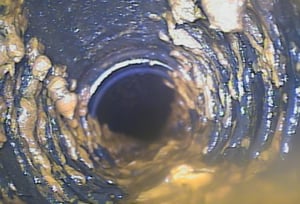An ECS Corrosion Assessment is used to determine the risk associated with corrosion of a fire sprinkler system in a given facility.
This risk can include the following:
- Damage due to leaks developing.
- Business interruption due to leaks.
- Risk of the system not operating as designed in the event of fire (caused by an obstruction or reduced water flow due to corrosion deposits).
The Corrosion Assessment typically consists of an on-site system review and a pipe sample analysis.
- System Review: By reviewing the layout of the system first hand and going through the history of the system with the service contractor and/or the building owner, we can select the optimal video scoping locations in order to identify the most severely corroded portions of the piping. If the systems in the building are all of typical design and history, we will select representative systems for inspection.
- Pipe Samples are selected at those locations where we find the most severe corrosion to quantify the severity of the metal loss and determine if pipe replacement may be necessary.
The video below shows a video scoping assessment of a 12-year old preaction system.
Even if leaks have already begun to develop in a sprinkler system, the damage is often localized to just a portion of the fire sprinkler piping. By identifying where the most severe corrosion has occurred, we can implement a plan for surgical pipe replacement in conjunction with a corrosion monitoring and control strategy. This helps to mitigate the risk of future leaks without the expense of complete system replacement.
Corrosion Location and Severity
There are several key characteristics that determine where corrosion occurs in a given system and how severe the corrosion is.
- Type of system: Wet vs. Dry/Pre-action
- Most severe corrosion in wet pipe systems occurs where trapped air is present.
- Most severe corrosion in dry pipe systems occurs where trapped water is present.
- Design/Installation of the system piping
- Flat system vs. Pitched
 Wet Systems – In a pitched wet pipe system, the trapped air present in the system will be isolated to just a small percentage of the system piping. All of the corrosive energy of the trapped oxygen in the trapped air will cause highly localized corrosion at the air/water interface in these locations. In flat wet pipe systems, the trapped air is spread throughout the system piping. This results in widespread, but less severe corrosion.
Wet Systems – In a pitched wet pipe system, the trapped air present in the system will be isolated to just a small percentage of the system piping. All of the corrosive energy of the trapped oxygen in the trapped air will cause highly localized corrosion at the air/water interface in these locations. In flat wet pipe systems, the trapped air is spread throughout the system piping. This results in widespread, but less severe corrosion.- Dry/Pre-Action Systems – Since liquid water is required for corrosion to occur, any section of pipe that contains no water will not corrode. While it is nearly impossible to remove all of the trapped water from a system, proper pitching and draining can greatly reduce the prevalence of corrosion in the system.
- Black Steel vs. Galvanized Steel
- The use of galvanized piping results in highly localized pitting, which can cause leaks in as little as 2-3 years after installation. Black steel experiences more generalized metal loss, but results in the formation of large amounts of iron oxide deposits, which can obstruct the pipe and sprinklers.
- Frequency of system testing, maintenance, modification, & repair
.jpg?width=300&name=IMG_2792(resized).jpg) In essence, any fire sprinkler system can be considered a stagnant pressure vessel. Oxygen present in the piping will react with the pipe metal, resulting in corrosion. This reaction consumes the oxygen. For additional oxygen corrosion to occur, the oxygen must be replenished.
In essence, any fire sprinkler system can be considered a stagnant pressure vessel. Oxygen present in the piping will react with the pipe metal, resulting in corrosion. This reaction consumes the oxygen. For additional oxygen corrosion to occur, the oxygen must be replenished.
In wet pipe systems, this only occurs when the system is drained. A vacuum forms as water drains from the system piping, pulling fresh air into the system piping. This fresh air is then trapped when the system is refilled, resulting in additional corrosion and metal loss at the system high points. The more often the system has been drained and filled since initial installation, the more severe the corrosion is going to be. As leaks begin to develop and the system is drained for repairs, corrosion will accelerate.- Dry systems whose supervisory gas is maintained by compressed air have a near limitless source of oxygen. Every time the air compressor turns on, additional oxygen-rich air is injected. The more often the air compressor turns on, the more oxygen is added, so once leaks begin to develop in the system corrosion will accelerate.
- Flat system vs. Pitched
Schedule Your Own Corrosion Assessment Today
Contact ECS today to speak with an engineer and discuss how a Corrosion Assessment can be used to help quantify and mitigate your risk. Let our experience with inspecting existing fire sprinkler systems develop a cost-effective, custom Corrosion Assessment for your building.
Getting started with your Corrosion Assessment is easy. Please submit a Corrosion Assessment Information Form to provide additional information about your system, and an ECS Engineer will contact you directly.



